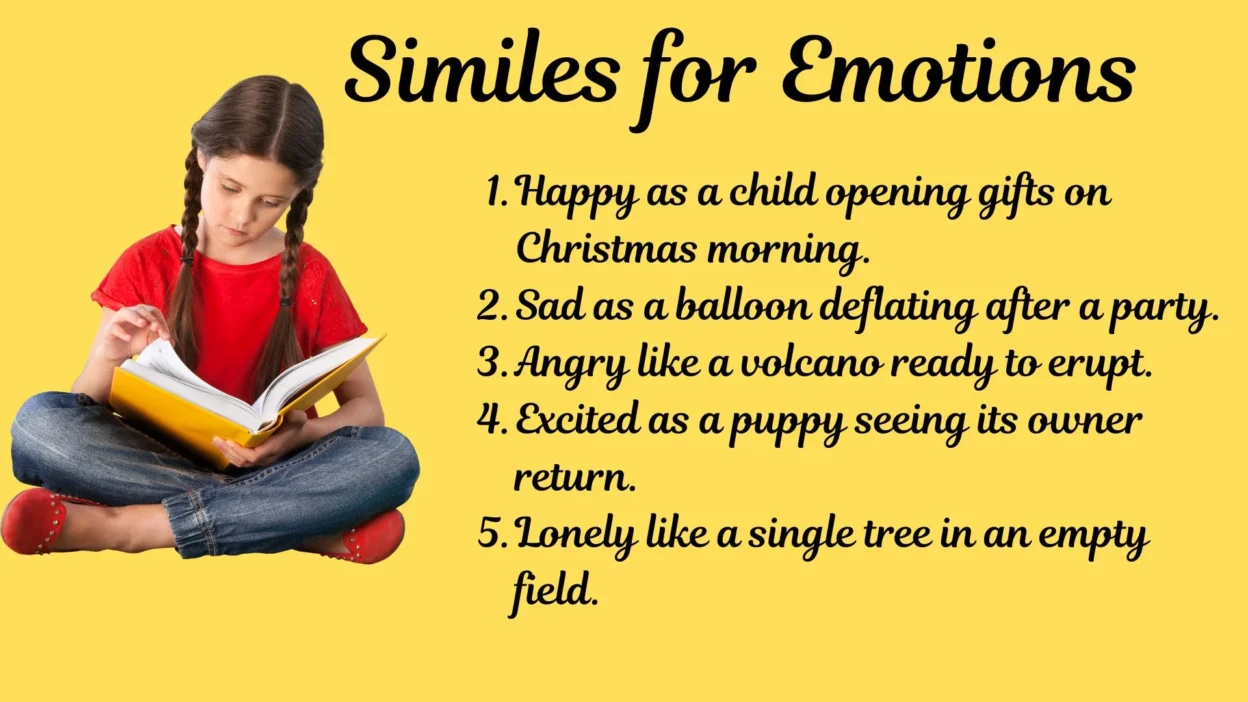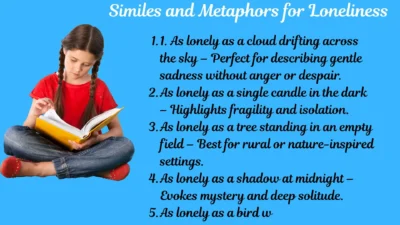Language has the power to capture feelings in ways that plain descriptions cannot. That’s why similes for emotions are so valuable—they help writers, students, and teachers express emotions vividly and memorably. Instead of simply saying “I was sad,” a simile allows you to say, “I felt as heavy as a rain-soaked coat,” creating imagery that resonates with the reader.
In this article, you’ll discover 45+ carefully explained emotional similes with examples, including 10 standout ones that go deeper. Whether you’re teaching children, writing stories, or learning expressive English, this guide will give you rich, ready-to-use comparisons.
Why Use Similes for Emotions?
Similes make abstract feelings tangible. Emotions are invisible—you can’t physically touch happiness, sadness, or fear. But by comparing them to something familiar, you make them real for the reader. For example, “Her anger burned like wildfire” is more powerful than just saying “She was angry.”
Writers, poets, students, and even teachers often search for:
- 10 similes examples for emotions
- list of similes for emotion
- simile for emotions examples sentences
This article covers all of these needs in one place.
10 Similes Examples for Emotions (Quick Start)
Here’s a starter set of simple yet impactful similes for emotions:
- Happy as a child opening gifts on Christmas morning.
- Sad as a balloon deflating after a party.
- Angry like a volcano ready to erupt.
- Excited as a puppy seeing its owner return.
- Lonely like a single tree in an empty field.
- Hopeful as a sunflower turning toward the sun.
- Scared like a mouse hiding from a cat.
- Calm as a lake on a windless day.
- Confused like a traveler without a map.
- Proud as a peacock spreading its feathers.
These are simple, kid-friendly examples. Let’s now expand into 35+ advanced similes with explanations and usage tips.
Complete List of Similes for Emotion with Examples
Happiness
- Happy as the first day of summer vacation.
– Best used for students and children, this simile captures carefree joy. - Joyful like sunlight breaking through clouds.
– Perfect in uplifting stories or poems. - Excited as a spark catching dry leaves.
– Highlights eagerness and unstoppable energy.
Sadness
- Sad as a forgotten song.
– A poetic simile for deep emotional loss. - Lonely like a bird with a broken wing.
– Expresses helplessness alongside sadness. - Miserable as a flower in a storm.
– Great for dramatic, visual writing.
Anger
- Angry like a kettle whistling on the stove.
– Suggests anger that’s about to boil over. - Furious as thunder cracking across the sky.
– Strong, intense imagery for powerful anger. - Bitter like burnt coffee.
– Best for resentment or grudges.
Fear
- Scared like footsteps echoing in the dark.
- Nervous as a leaf trembling in the wind.
- Frightened like glass about to shatter.
Love & Affection
- Love as warm as a blanket in winter.
- Tender like petals on a rose.
- Affectionate as a cat rubbing against your leg.
Confusion
- Confused like puzzle pieces that don’t fit.
- Lost as a ship without a compass.
- Perplexed like a riddle with no answer.
Hope
- Hopeful as dawn breaking after a storm.
- Optimistic like seeds waiting to sprout.
- Bright as a candle in darkness.
Calm & Peace
- Calm as freshly fallen snow.
- Peaceful like waves lapping against the shore.
- Serene as a child asleep in a mother’s arms.
Highlighted Emotional Similes (Extra Detail – Top 10)
Let’s explore 10 standout similes with deeper explanations, tone variations, and usage tips:
- “Angry like a volcano ready to erupt.”
– Best for characters holding back explosive emotions. Can be used in both dramatic and humorous contexts depending on tone. - “Sad as a balloon deflating after a party.”
– Children relate easily to this image; teachers can use it in lessons about figurative language. - “Excited as a puppy seeing its owner return.”
– Captures pure, unfiltered joy. Works beautifully in children’s writing or light-hearted stories. - “Lonely like a single tree in an empty field.”
– Evokes both beauty and sorrow, suitable for poetry. - “Hopeful as a sunflower turning toward the sun.”
– Symbolic and uplifting; ideal in motivational writing. - “Scared like a mouse hiding from a cat.”
– Universal image, easy for learners to grasp. - “Confused like a traveler without a map.”
– Clear and educational, excellent for ESL learners. - “Joyful like sunlight breaking through clouds.”
– Dramatic and hopeful, perfect for inspirational stories. - “Peaceful like waves lapping against the shore.”
– Gentle, soothing; often used in mindfulness writing. - “Proud as a peacock spreading its feathers.”
– Bright, colorful imagery for moments of triumph.
Similes and Metaphors for Emotions: What’s the Difference?
- Similes use comparison words like “as” or “like.” Example: “Her anger was like fire.”
- Metaphors state one thing is another. Example: “Her anger was fire.”
Both are useful, but similes are often easier for beginners and students to create.
Simile for Emotions Example Sentences
Here are full-sentence applications:
- “After hearing the good news, Sarah was happy as the first day of summer vacation.”
- “When he lost his toy, the boy looked sad as a balloon deflating after a party.”
- “She grew angry like a kettle whistling on the stove.”
- “The child stood scared like a mouse hiding from a cat.”
How Teachers and Parents Can Use Emotional Similes
- In classrooms: Use them as writing prompts or creative warm-ups.
- At home: Encourage children to describe their day using one simile.
- For writers: Insert them into dialogue and narrative to avoid flat emotional descriptions.
Conclusion
Similes for emotions unlock the power of expression by turning invisible feelings into vivid imagery. With over 45 examples and detailed explanations, this guide gives students, teachers, and writers a complete toolbox for creative expression. Whether you’re teaching children, writing stories, or practicing English, similes make emotions memorable, relatable, and deeply human.




